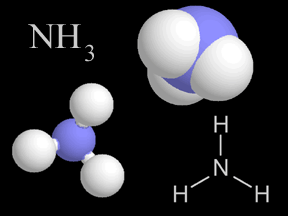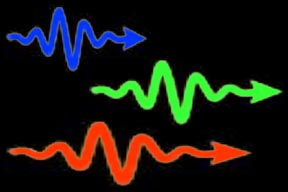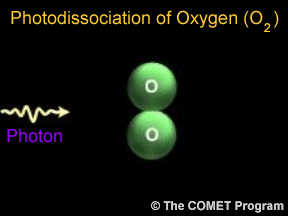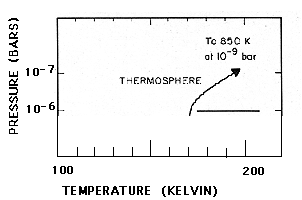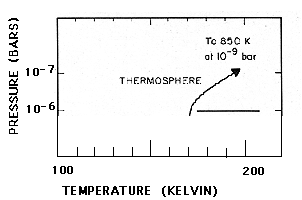Click on image for full size
Courtesy of NASA
The Thermosphere
The thermosphere is a layer of Earth's atmosphere. The thermosphere is directly above the mesosphere and below the exosphere. It extends from about 90 km (56 miles) to between 500 and 1,000 km (311 to 621 miles) above our planet.
Temperatures climb sharply in the lower thermosphere (below 200 to 300 km altitude), then level off and hold fairly steady with increasing altitude above that height. Solar activity strongly influences temperature in the thermosphere. The thermosphere is typically about 200° C (360° F) hotter in the daytime than at night, and roughly 500° C (900° F) hotter when the Sun is very active than at other times. Temperatures in the upper thermosphere can range from about 500° C (932° F) to 2,000° C (3,632° F) or higher.
The boundary between the thermosphere and the exosphere above it is called the thermopause. At the bottom of the thermosphere is the mesopause, the boundary between the thermosphere and the mesosphere below.
Although the thermosphere is considered part of Earth's atmosphere, the air density is so low in this layer that most of the thermosphere is what we normally think of as outer space. In fact, the most common definition says that space begins at an altitude of 100 km (62 miles), slightly above the mesopause at the bottom of the thermosphere. The space shuttle and the International Space Station both orbit Earth within the thermosphere!
Below the thermosphere, gases made of different types of atoms and molecules are thoroughly mixed together by turbulence in the atmosphere. Air in the lower atmosphere is mainly composed of the familiar blend of about 80% nitrogen molecules (N2) and about 20% oxygen molecules (O2). In the thermosphere and above, gas particles collide so infrequently that the gases become somewhat separated based on the types of chemical elements they contain. Energetic ultraviolet and X-ray photons from the Sun also break apart molecules in the thermosphere. In the upper thermosphere, atomic oxygen (O), atomic nitrogen (N), and helium (He) are the main components of air.
Much of the X-ray and UV radiation from the Sun is absorbed in the thermosphere. When the Sun is very active and emitting more high energy radiation, the thermosphere gets hotter and expands or "puffs up". Because of this, the height of the top of the thermosphere (the thermopause) varies. The thermopause is found at an altitude between 500 km and 1,000 km or higher. Since many satellites orbit within the thermosphere, changes in the density of (the very, very thin) air at orbital altitudes brought on by heating and expansion of the thermosphere generates a drag force on satellites. Engineers must take this varying drag into account when calculating orbits, and satellites occasionally need to be boosted higher to offset the effects of the drag force.
High-energy solar photons also tear electrons away from gas particles in the thermosphere, creating electrically-charged ions of atoms and molecules. Earth's ionosphere, composed of several regions of such ionized particles in the atmosphere, overlaps with and shares the same space with the electrically neutral thermosphere.
Like the oceans, Earth's atmosphere has waves and tides within it. These waves and tides help move energy around within the atmosphere, including the thermosphere. Winds and the overall circulation in the thermosphere are largely driven by these tides and waves. Moving ions, dragged along by collisions with the electrically neutral gases, produce powerful electrical currents in some parts of the thermosphere.
Finally, the aurora (the Southern and Northern Lights) primarily occur in the thermosphere. Charged particles (electrons, protons, and other ions) from space collide with atoms and molecules in the thermosphere at high latitudes, exciting them into higher energy states. Those atoms and molecules shed this excess energy by emitting photons of light, which we see as colorful auroral displays.








